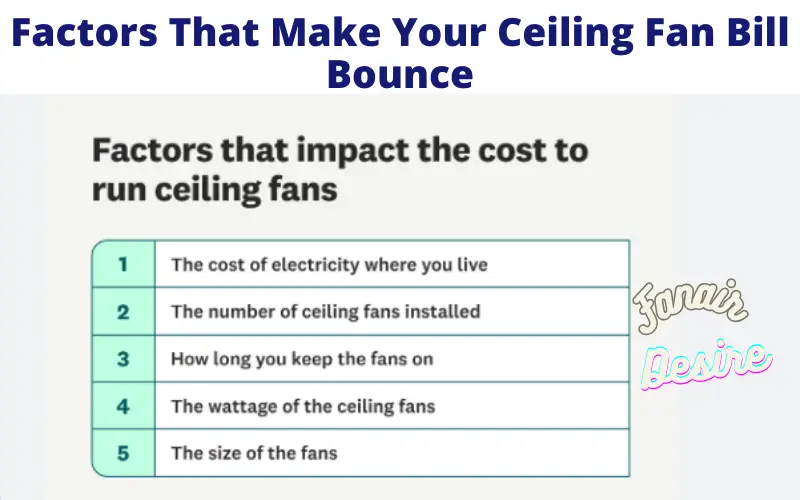Ceiling fans have been our trusty companions in the battle against sweltering summers for generations. They are the unsung heroes of cooling, quietly spinning above our heads, and making us feel cooler by circulating the air. But have you ever wondered how much does it cost to run a ceiling fan?
In this article, we’re going to take a close look at the cost of operating a ceiling fan while keeping things friendly and unique.
Deciphering Ceiling Fan Energy Usage: How Much Does It Cost to Run a Ceiling Fan?
Before we get into the nitty-gritty of costs, let’s unravel the mysteries of how ceiling fans consume energy. Unlike air conditioners that work their magic by cooling the air, ceiling fans operate differently:
Motor Power: How Much Does It Cost to Run a Ceiling Fan?
Each ceiling fan is equipped with a motor that powers the blades. The motor’s power is measured in watts, and it can vary from fan to fan. Typically, the higher the wattage, the more electricity it uses.
Speed Settings: How Much Does It Cost to Run a Ceiling Fan?
Most ceiling fans come with multiple speed settings. You can tweak the fan’s intensity to suit your comfort level. But keep in mind that higher fan speeds gobble up more energy compared to the slower settings.
Duration of Use: How Much Does It Cost to Run a Ceiling Fan?
The longer your ceiling fan runs, the more energy it consumes. Fans left on for extended periods will inevitably show up on your energy bill.
Location and Climate: How Much Does It Cost to Run a Ceiling Fan?
The effectiveness of your ceiling fan can be influenced by factors like room size, ceiling height, and local climate. In hotter regions, your fan might need to work a little harder to keep you comfortable.
Now that we’re familiar with the basics let’s crunch the numbers to determine the cost of running your ceiling fan.
Calculating the Price Tag of Ceiling Fan Comfort
To figure out the cost of operating your ceiling fan, you need to take a few factors into account:
Wattage: How Much Does It Cost to Run a Ceiling Fan?
Check the wattage rating of your ceiling fan. You can usually find this information on a label or in the user manual. Ceiling fans typically consume anywhere from 10 to 120 watts.
Electricity Rate: How Much Does It Cost to Run a Ceiling Fan?
The cost of electricity isn’t the same everywhere. It varies based on your location and can be found on your utility bill, usually measured in cents per kilowatt-hour (¢/kWh).
Hours of Operation: How Much Does It Cost to Run a Ceiling Fan?
Decide how many hours per day you want to run your ceiling fan. This largely depends on your comfort needs and the local climate.
With these numbers in hand, you can use the following formula to calculate both daily and monthly energy costs for your ceiling fan:
Energy Cost ($) = (Wattage / 1000) x Hours of Operation x Electricity Rate
Let’s put this formula into practice with an example:
Example: How Much Does It Cost to Run a Ceiling Fan?
- Ceiling Fan Wattage: 75 watts
- Electricity Rate: $0.12/kWh
- Hours of Operation per Day: 8 hours
Using the formula: How Much Does It Cost to Run a Ceiling Fan?
- Energy Cost ($) = (75 / 1000) x 8 x $0.12 = $0.072 per day
- And to calculate the monthly cost:
- Monthly Cost ($) = Daily Cost x 30 days = $0.072 x 30 = $2.16 per month
So, in this example, running your ceiling fan for 8 hours a day would cost you approximately $2.16 per month.
Factors That Make Your Ceiling Fan Bill Bounce

The energy costs of your ceiling fan can be influenced by several factors:
Fan Efficiency: Ceiling fans that carry the ENERGY STAR certification tend to be more energy-efficient, offering the same comfort at a lower cost.
Fan Size: Larger fans typically have higher wattage ratings and can consume more electricity compared to their smaller counterparts.
Climate: In regions with hot and humid weather, you may find yourself running your ceiling fan for extended periods, which can lead to higher energy costs.
Ceiling Height: Ceiling fans installed in rooms with high ceilings may require more energy to circulate air effectively.
Usage Patterns: If you’re a frequent user of your ceiling fan, expect your monthly energy costs to be higher. Conversely, if you use it sparingly, you’ll see lower costs.
Tips to Keep Your Ceiling Fan Costs in Check
While ceiling fans are generally kind to your energy bill, there are some clever ways to further reduce their energy consumption and costs:
Opt for Energy-Efficient Fans:
When shopping for a ceiling fan, look out for the ENERGY STAR label. These fans meet stringent energy efficiency standards, offering savings in the long run.
Coordinate with your Thermostat:
Use your ceiling fan in tandem with your air conditioner to distribute cooled air more efficiently. This might allow you to set your thermostat a bit higher, reducing overall energy usage.
Regular TLC:
Keep your ceiling fan in top shape by cleaning its blades and ensuring they’re well-balanced. Dirty or wobbly fans can end up consuming more energy.
Operate Mindfully:
Remember that ceiling fans cool people, not rooms. Turn them off when you leave a room to avoid unnecessary energy consumption.
Invest in Smart Controls:
Consider installing a smart fan controller that allows you to adjust fan speed and timing remotely. This way, you can ensure your fan isn’t running longer than necessary.
Conclusion: Balancing Comfort and Cost
Ceiling fans can be a cost-effective way to stay comfortable in your home while also reducing your reliance on air conditioning. Understanding the factors that contribute to energy costs and following energy-saving practices can help you enjoy the benefits of ceiling fans without a significant impact on your monthly utility bills.
By choosing energy-efficient fans and using them wisely, you can strike a balance between comfort and cost-effectiveness in your home. So, keep those ceiling fans spinning, and stay cool without breaking the bank!

